Watering onions after planting outdoors: how to water properly and when to stop
What dacha does not grow onions, no matter for a turnip (head) or a feather (greens)? However, not every gardener can boast of large and juicy bulbs. This is understandable: after all, in order to get the most from the culture, you need to take care of it, including watering correctly.
Next, let's talk in more detail about how to water onions after planting in open ground, as well as when all watering should be stopped in order to get a rich harvest.
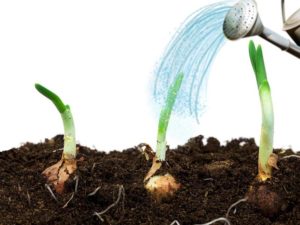
Content
Why is it important to water the onions on time and correctly
Any plant needs moisture for good growth and normal development. Naturally, onions are no exception.
However, as with any business, there is always a balance to be struck.Therefore, in no case should the onion be allowed to dry out due to lack of moisture, as, indeed, turn the onion bed into a swamp.
Note! Drought for onions is a signal that it is time to pump up the growing season, in other words, if you do not water the onions during its growth, then the bulbs simply will not gain weight and remain small.
Also with insufficient watering during the growth period, the onion becomes more bitter.
And due to excess moisture, especially at the end of the growing season, if you continue to water the onions, the bulbs may simply become watery or begin to rot.
Drip irrigation
Of course, drip irrigation is ideal for watering all vegetables. Yes, onions are a relatively moisture-loving crop, but few people grow them on such a scale that it is reasonable to use drip irrigation.
It's another matter if you grow onions for sale. However, this is a completely different story: here we are talking about amateur gardening.
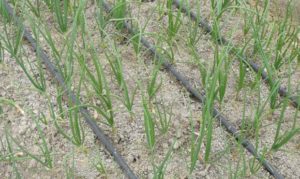
Mulching
Instead of installing expensive drip irrigation, it is much easier to simply mulch your onion beds. Then, not only will you not have to water the onions often, but you will also practically get rid of such procedures unloved by all summer residents as loosening and weeding from weeds.
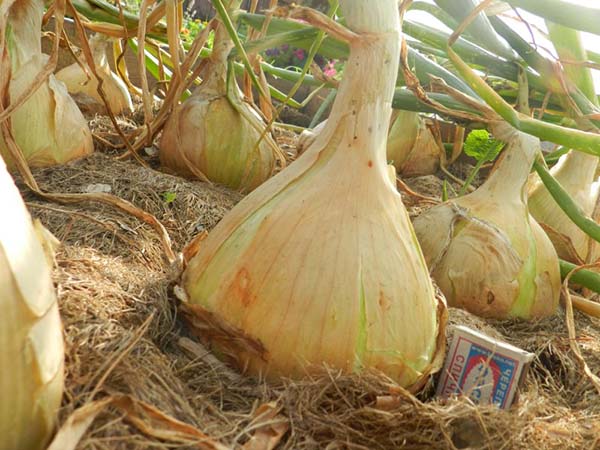
If you grow without mulching, then after each watering it is advisable to loosen the ground and periodically weed it (read about the nuances below), and the weeded grass can be left right on the garden bed, it will play the role of mulch in the future.
Loosening and weeding
If you do not mulch the beds, then you will need to periodically loosen and weed between the bulbs in order for the plant to receive enough oxygen necessary for development.
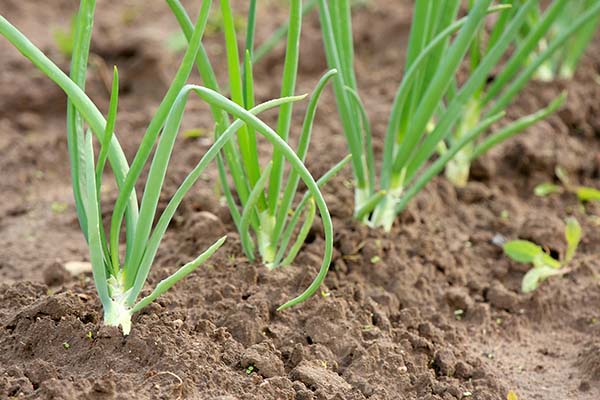
This event is also needed in order to so that a dense earth crust does not form on the surface, which does not allow moisture and all the same oxygen to flow to plants evenly.
Periodically loosening should be combined with weeding to eliminate fast growing weeds.
Advice! Once the bulbs have reached medium size, you will need to gradually start scooping up soil from them, which will help them grow in size and ripen quickly.
How to properly water onions outdoors
Basic rules and tips for watering onions to help you take proper care of your plant:
- For watering onions, it is advisable to use warm and settled water, but cool enough will do (too cold can cause oppression of the plant).
Note! Using ice water directly from a well is a very bad idea, but using a hose is quite an option.
- You can water the onions in the morning (before lunch) or in the evening (after 17-19 hours).
It is not recommended to water the onion during the day, since moisture evaporates quickly under the influence of sunlight and burns form on the leaves.
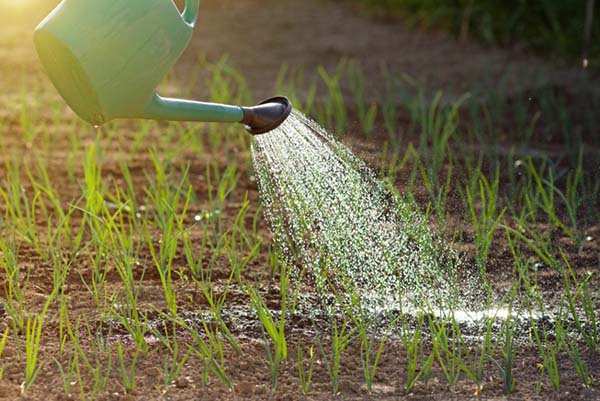
- You can water the onion either at the root or along the grooves, or by sprinkling.
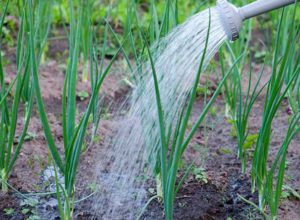
- The frequency and rate (volume) of irrigation depend on the stage of onion vegetation and weather conditions.
Naturally, if the days are hot, the weather is dry, it is necessary to increase the amount of watering, rainy ones - to minimize.
- To determine whether it is worth watering the onion, a shallow hole is dug in the aisle and a handful of earth is scooped up from the bottom. If, after opening the palm, the earth crumbles, then the bed needs to be watered, and if it sticks together and keeps its shape (moisture oozes out of it - a sign of overflow), then there is no need for watering.
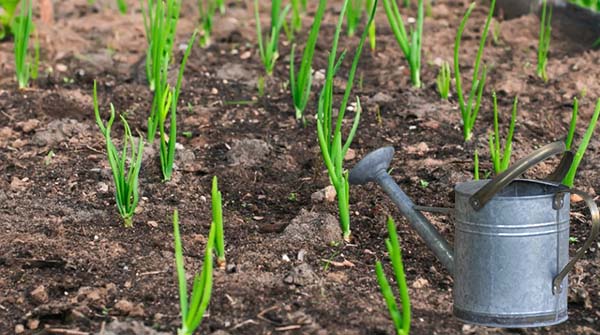
When and how to water onions: rate and frequency of watering
As a rule, most gardeners use the following onion watering scheme during its growing season:
Note! Onions on a feather (greens) are watered in the same way as onions grown on a turnip (head).
The only difference between watering depending on the purpose of growing (for a turnip or a feather) is the period of artificial drought, which is done before harvesting.
Onions on a turnip stop watering 2-3 weeks before harvest, a onions on a feather - 5-7 days before the first cut of greens. This is done to keep the feather dry - it will keep better and longer. Otherwise moist greens will deteriorate in a fairly short time.
After landing
- Special a lot of moisture is required after planting for early rooting of the bulbs.
Interesting! Some gardeners are too zealous with watering and create virtually "swamp" conditions in which the bulbs literally float in the water.
Indeed, before rooting (when the bulbs take root and grow), the onions need to be watered more often and more.
However, it should be understood that with an excess of moisture in the soil bulbs may simply start to rot, therefore, do not "flood" the plants.
During growth and weight gain
- Then (after the bulbs have taken root and started to grow) the need for moisture decreases, but only a little, i.e. watering should be done as needed and depending on weather conditions.
For example, if it rains often, then you can practically not water. But if the weather is dry and hot, about + 25-30 degrees, then it is recommended to water the onion every 5-7 days.
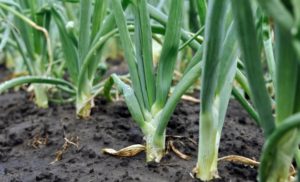
When to stop watering (before harvest)
- As the onion harvest approaches, the frequency of watering is gradually reduced.
- In this way, keep the soil slightly moist in onion beds it is necessary until a constriction appears on the neck of the bow (i.e. it will begin to thin and soften) and the feather will not gradually start to lie down.
The lodging of the feather indicates that the growing season of the onion is nearing completion.
- And when green onions will begin to actively lie on the groundthen 2-3 weeks before harvest any watering need to to stop at all.
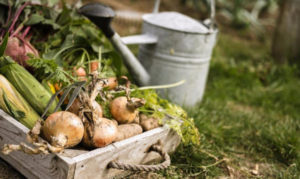
Important! If it is rainy weather and the onions are almost ready for harvesting, then you should try to somehow close the garden bed from rainfall (for example, with polyethylene), otherwise secondary growth may simply begin (the bulbs will start to re-start "arrows"), which will negatively affect the final the quality and quantity of the crop.
Excessive moisture during the ripening period of the onion will certainly lead to its rotting and poor keeping quality, or the turnip will become too watery.
Combining onion watering with feeding
Often, many gardeners combine watering with liquid fertilizing.
Important! However, even before liquid top dressing, it is first recommended to water (about a day or a couple of hours), and in the case of sprinkling, after top dressing, water the onion feathers with clean water.
Very often at the beginning of the growing season, onions watered with salt water (1-2 tablespoons per 10 liters of water) in order to prevent the appearance of onion flour (due to its activity, the tip of the feather turns yellow, and then dries up) and scaring away other pests, so as not to let them lay eggs, of which then the larvae will hatch.
Many gardeners are afraid to do salt treatment because they are afraid to salt the soil and spoil the taste of the turnips. However, if the plants are watered with a solution of the specified concentration, then you will not cause any harm.
Note! Contrary to popular misconception, the ripening rate of onions does not increase from watering with salt.
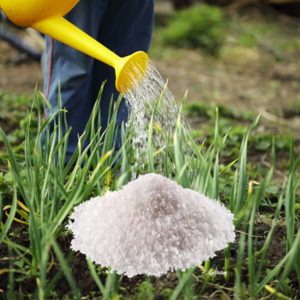
Advice! The site already has an article about how and what to feed onions in spring and summer in order to get large bulbs.
As you can see, watering the onion is not that difficult. The main thing to remember is after landing and to a slightly lesser extent during growth and development, the soil in the garden should be barely wetand when the bulbs begin to ripen and during the last 2-3 weeks before harvest - dry.
Video: how often to water onions


Hello. Tell me when and how to water winter onions in spring? The sprouts are still small, they got out 2 weeks ago, but the weather is dry +24 and the sun is very hot.
Good day! If the weather is dry and sunny, then water every 5-7 days (week) or even more often. The soil under the onions should be only slightly moist (in no case waterlogged), but not dry either.